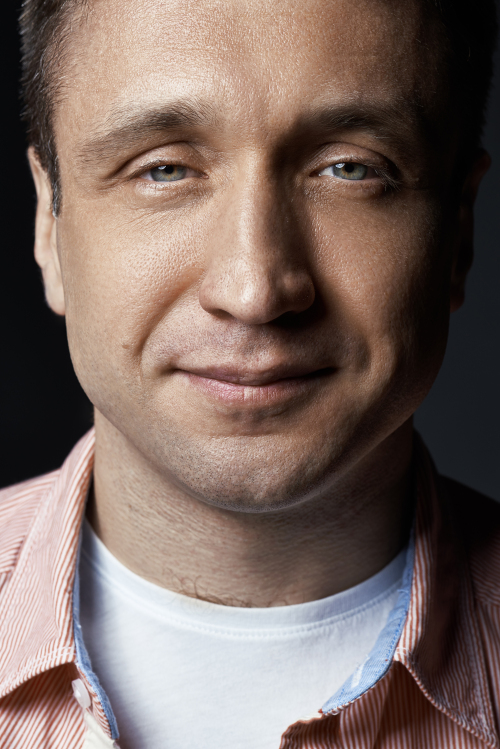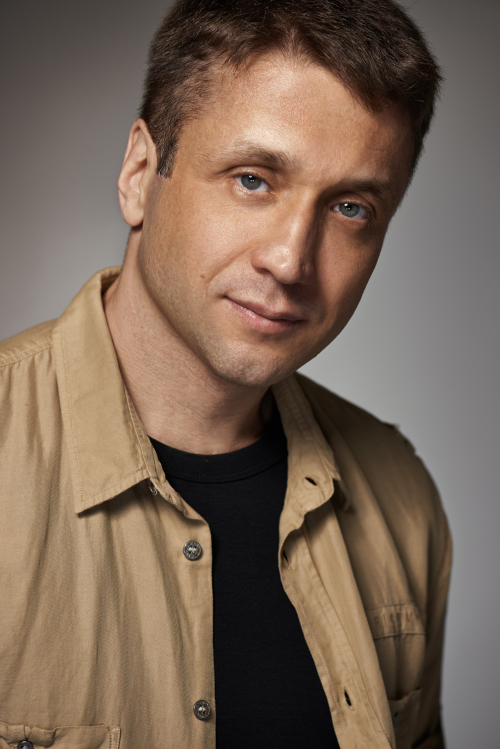 Yuri Selukoff, the creator of the popular PDF reader app for iPhone and iPad, GoodReader, is 42. That happens to be the same age as another successful Russian-born high-tech entrepreneur residing in the Silicon Valley, Sergey Brin. But unlike the Google co-founder, who arrived in the U.S. with his family when he was 6 years old and took a now-familiar immigrant wunderkind route to tech stardom, Selukoff’s success not only came much later, but almost never happened.
Yuri Selukoff, the creator of the popular PDF reader app for iPhone and iPad, GoodReader, is 42. That happens to be the same age as another successful Russian-born high-tech entrepreneur residing in the Silicon Valley, Sergey Brin. But unlike the Google co-founder, who arrived in the U.S. with his family when he was 6 years old and took a now-familiar immigrant wunderkind route to tech stardom, Selukoff’s success not only came much later, but almost never happened.
While Brin grew up in the 80s with easy access to desktop PCs, Selukoff learned programming from library books. While Brin was studying computer science at Stanford, Selukoff was selling used imported BMWs to newly-capitalist Russians. While Brin was writing the code with Larry Page for what became the Google search engine, Selukoff was the tour manager for a Russian boy band. And while Google was going IPO in 2004 making Brin an instant billionaire, Selukoff was scraping by in Moscow, running a factory manufacturing compact discs.
“My entire career has been a pure set of accidents,” said Selukoff in a recent conversation at BlackBerry’s Silicon Valley office.
(Before I continue, let me clear up any possible confusion. GoodReader and Selukoff’s company, Good.iWare, are separate from Good Technology, which BlackBerry acquired last fall. However, in 2012 Selukoff created a special secure version called GoodReader for Good that is one of the most popular of the many 3rd-party apps integrated into the Good platform. Enterprise users of GoodReader for Good include Bank of New Zealand, wireless equipment maker Rohde & Schwarz, global insurer JLT, and many, many more. And for GoodReader users, good news! A new version released yesterday. Read on to learn more.)
Destiny, Almost Interrupted
Born in the southwestern industrial city of Volgograd, Selukoff’s father “built machines that built machines” for Soviet state-owned enterprises, while his mother was the U.S.S.R. equivalent of a patent lawyer. When he was 15, Selukoff was one of a few hundred students to be admitted into the Soviet Union’s top high school for math and science. He remembers the grueling two-week admissions tests as being as much “psychological” as academic. “There were a lot of nervous breakdowns, kids who burst into tears and went home,” he said.
Everything changed with the fall of the U.S.S.R. in 1991. The resulting upheaval claimed both his parents’ jobs while he was in his second year at Moscow State University. Forced to drop out, the 20-year-old Selukoff began selling used German cars while playing bass in a punk rock band on the side. The band was wholly unsuccessful, but it was a steppingstone to Selukoff’s next job, managing Russian pop bands. “Like Backstreet Boys or N’Sync,” he said.
Being a tour manager let Selukoff travel – he remembers flying 12 hours to the U.S. for a concert, spending two days and then flying straight back. It also gave Selukoff an MBA from the streets. “You get a lot of business experience fast talking to people, figuring out when they are lying to you, how to make deals,” he said.
 Tiring of the travel and the compensation, Selukoff switched gears, building a factory in Moscow that manufactured CDs and DVDs. He ran the factory for more than a decade, until the mainstreaming of digital music among Russians caused orders to dwindle. By the late 2000s, Selukoff was ready for another opportunity.
Tiring of the travel and the compensation, Selukoff switched gears, building a factory in Moscow that manufactured CDs and DVDs. He ran the factory for more than a decade, until the mainstreaming of digital music among Russians caused orders to dwindle. By the late 2000s, Selukoff was ready for another opportunity.
Full Circle
Rewind back to 1990: 16-year-old Selukoff comes to the U.S. for a month-long summer camp. In retrospect, it was life-changing.
“If you can imagine how miserable and 3rd-world life was in Soviet Union at the time, and then to walk into a classroom with 40 real IBM PCs, it was like WOW!” he said. “Some kind of dream was planted into my head.”
Selukoff came back to Russia, determined to get as much computer time as possible, even deigning to “play the teacher’s pet.”
But after he dropped out of university, Selukoff’s contact with technology cooled. For almost a decade and a half, Selukoff was just a normal user, emailing, filling out spreadsheets, creating the occasional band poster.
Then on his 35th birthday, Selukoff receives an iPhone as a present. The iPhone was so fresh at the time that there was no App Store, meaning you had to jailbreak (hack) the phone to install any apps. Selukoff did that, and more. Hating iOS’s built-in calculator, Selukoff decided to write his own. He wasn’t totally rusty – while running his CD factory, Selukoff had learned SQL (database programming language) to customize his accounting software. “The hardest part was drawing the buttons,” he said. In opposition of Apple’s “bad” calculator app, he called his the “Good Calculator.”
Good Calculator was a practice run – it got 40,000 downloads, but earned Selukoff no money. His next app was spurred by similar discontent – in this case, with iOS’s clunky file management and storage, and also with early PDF readers for the iPhone, which kept crashing every time he tried to open a map or other large document. Selukoff decided he could do better.
Released in early 2009, v1 of GoodReader quickly gained loyal fans. But sales of the paid version were slow. But when Apple released the iPad in early 2010, Selukoff was ready. Within the first 3 weeks of its release, GoodReader for iPad had received 70,000 paid downloads at $0.99 apiece, as chronicled by BusinessInsider. Endorsements from influential tech publications such as CNET and Macworld added to the hype. By the end of 2010, GoodReader was the top-selling non-Apple app for iPad, despite “zero marketing effort” by Selukoff.
As more quality PDF readers appeared, Selukoff maintained GoodReader’s edge by being the first to market with many features. Improved document editing and annotations. iCloud drive integration. Text-to-speech. The ability to encrypt and read encrypted files.
GoodReader’s security features were key to its popularity with enterprises. Yale Medical School armed its medical students with iPads installed with GoodReader, while Alaska Airlines and Delta Airlines both dumped heavy flight bags for iPads armed with maps and GoodReader. And many, many more, though Selukoff says the App Store’s anonymous purchasing model means that he only finds out later through news stories what companies or government institutions have bought GoodReader.
It was a government organization that brought GoodReader into the public eye. In early 2012, I wrote a blog for Forbes about U.S. Air Force officials’ cancellation of a planned deployment of 3,000 iPads running GoodReader after a U.S. political news web site, NextGov, raised the security risk of using encryption supplied by a Russian company.
Selukoff sarcastically rebuffed accusations of spyware or compromised code and denied any association with any government agency, Russian or otherwise.
Not having spoken directly to Selukoff at the time, my opinion was that using GoodReader could be risky – not because Selukoff was a KGB operative, but because of the many potential hands touching the iPads before they arrived to the Air Force. The solution, I wrote, was to actively manage these iPads and GoodReader using certified Mobile Device Management (MDM) software. And that essentially became possible 6 months later when GoodReader was integrated into Good Technology’s MDM suite and leveraged the latter’s encryption.
The controversy didn’t seem to hurt GoodReader’s sales or its reviews. “An excellent universal app for PDF management,” was the headline of a 2014 Macworld review that gave GoodReader 5 out of 5 stars. “This is the best all-purpose app on iOS, and a must-have utility,” wrote 148Apps.com. The $4.99 app today has 4.5 stars out of 5 from 3,572 reviews at Apple’s App Store.
Starting Up Again in Silicon Valley
The irony of the controversy, says Selukoff, is that he has little love for the Russian government.
Moved into action by Russia’s invasion of Crimea, Selukoff quietly applied for a U.S. visa in late 2014. An EB-1 visa, aimed at an ‘Alien of Extraordinary Ability’ is the rarest and most difficult visa to be granted; Winners tend to be “to Nobel prize quality or equivalent,” one expert told Businessweek magazine. But as with his high school admissions, Selukoff bucked the long odds, based on his success with GoodReader. It still took an extraordinary amount of paperwork (see the picture left), which Selukoff points out was ironic for the creator of a digital document reader – as well as time, forcing Selukoff to abandon any development work on GoodReader for almost a year. When the visa finally did come through last July, Selukoff quickly sold all of his possessions and booked a one-way ticket from Moscow to San Francisco without telling even his friends.
Appropriately, he resettled in San Francisco’s SoMa neighborhood, the hub of the local startup scene. There, he has been busy working on a belated update to GoodReader. The last version from March 2015 let users quickly add secure e-signatures to documents using Apple’s fingerprint scanner, Touch ID.
Released to Apple’s App Store late last night, GoodReader’s latest 4.12 update adds support for the new iPad Pro tablet, as well as iOS 9’s multi-tasking features, Slide Over and Split View, which let users run and view multiple apps at a time. Selukoff promises that a much-bigger update with more new features is “coming soon.”
As for the perpetual question of when he’s bringing GoodReader to Android devices (such as the BlackBerry PRIV), Selukoff says he is preparing to do just that. He’s setting up a proper company for the first time and interviewing developers to write it for him, though he vows that he’ll maintain the same standard of quality that brought GoodReader its earlier success.
“I can go to a university and find 1,000 people better at coding than me. But my talent is the decisionmaking, and ensuring the user experience,” he said. “So you’ll never see a half-baked product come out under my name.”

